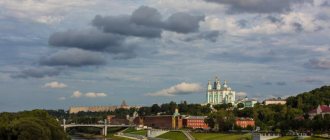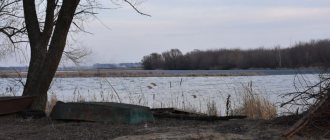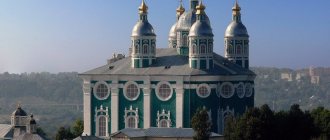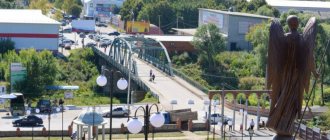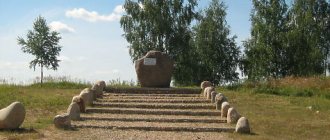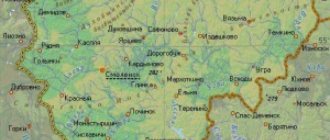Sychevka as a mirror of the Smolensk province
Once upon a time, a long time ago, during the Soviet system, a solid livestock complex was built near the village of Svetetskoye, in the Sychevsky district. The road to it through a swamp of 300 meters was paved with reinforced concrete slabs. Local residents could not be happier - there is a reliable connection with the entire district and the regional center. But the bourgeois-oligarchic revolution broke out in Russia - and the utter ruin of everything and everyone began, and, above all, agriculture, abandoned to the mercy of fate. Everything on the local collective farm also collapsed. It got to the point that a few years ago some people arrived with a truck crane and cars, pulled out the road slabs and took them away to God knows where. Now, as soon as it rains, the villagers will not be able to get through, they will not be able to get through.
“Wherever we turned with our troubles: to the police and to the district administration.” They didn’t get any sense: who destroyed the road, why, how can people continue to survive? - Petr Nikolaevich Viktorenkov, a former machine operator who has state awards for his work, complained to State Duma deputy A.V. Kazakov during his recent reception of citizens in Sychevka. – Once Zhirinovsky’s train stopped in our regional center. My brother-in-law managed to convey to him our request for help. So what. He sent the paper to Ostrovsky in Smolensk, and Ostrovsky to the head of the district administration, Orlov. Orlov promised in writing that in 2014 the Sutormino-Svetetskoye road would be taken over by the municipality and put in order, but nothing has been done so far. It turns out that everyone has no time for us. Yes, only a few people live in the village all year round. But we are people too and we want to live. Neither the ambulance gets to us, nor the fire truck, nor anything.
It's an ugly situation, to put it bluntly. And there are many similar ones in the area. It is no coincidence that most of the 23 people who came to see the deputy spoke so impartially about Sychev officials, headed by Mr. Orlov since 2010. People claimed that during the “Orlovschina” the area was in complete decline. The city-forming electrode plant is closed (see title photo). Agricultural production has been practically destroyed. The largest livestock complex, which was created to accommodate a modern, high-tech milk processing plant opened in Sychevka at the beginning of the century, was ruined. He is also on his last legs now. The local bakery is on the verge of survival. The municipality is depopulating. Sychevites leave in search of work and a better life in neighboring areas and in Moscow.
The local housing and communal services system is fragmented. The garbage disposal is disgusting. Many sewage flows into Vazuzu. Sychevites are not satisfied with the repair of housing stock and roads. The streets Svobodnaya, Krasnoarmeyskaya, Grigoryeva, Vinokurova, Krestyanskaya, Lomonosova, instead of a sand-gravel mixture, are filled with coarse crushed stone, which is now simply a pain to walk on.
Olga Ivanovna Vasilyeva is outraged by the way the capital renovation program for apartment buildings has been implemented in the region. Here's an example. Almost 1.3 million rubles were allocated for one of the houses on Bolshaya Sovetskaya Street. Despite complaints from residents, officials signed an acceptance certificate for the completed work. An independent construction examination showed that the total amount of repairs not carried out, as provided for in the estimate, amounted to more than 600 thousand rubles. A criminal case was opened on this fact. However, the bosses are like water off a duck's back.
It is impossible to get to the regional center from many villages. For example, the bus goes to the village of Lesnye Dali only on Mondays, and even then irregularly. The paramedic and midwife station there has been liquidated, how can sick people get to the district hospital? Unanswered question.
There is a real problem in a number of settlements with water supply. In the village of Yablontsevo, as Valentina Afanasyevna Zharkova said, people have to scoop dirty brown liquid from holes formed on the site of former water points of a long-rotten water supply system. The situation in the village of Vasilevka is even worse. They built a mine well there, which has no water. The leadership of the Seredsky settlement offers residents to purchase bottled water delivered by a water store, or to buy a tanker themselves, however, no one can really tell citizens who, on what and from where the water will be delivered in this container. They can't wait to see the construction of wells in the villages of Lukino and Burtsevo.
With undisguised bitterness, a group of members of the production cooperative “Collective Farm “Rassvet” told Alexey Valerievich about the ongoing dispossession of their farm. Many families here are left without work and livelihood. The agricultural enterprise, through the efforts of its director V.A. Sigina, is being brought, according to the applicants, to deliberate bankruptcy. Equipment, cattle, buildings and structures are sold without the consent of the general meeting. Collective farmers do not know where the proceeds go. Property shares are not allocated to them. They don’t allow housing to be privatized: pay 70-100 thousand rubles, then there will only be a conversation. The villagers despaired of finding protection anywhere, believing that district officials and local law enforcement officers were covering up for Ms. Sigina.
Long ago, the problem of capital repairs of housing in rural areas, which were once transferred to municipal ownership, became overdue in the region. For more than ten years, V.A. Zharkov from Yablontsev has been trying to put his former state farm apartment in order. Tatyana Afanasyevna Savina from the village of Nikitye, Karavaevsky rural settlement, and her disabled husband live in constant fear in the damaged half of the house, where the roof could collapse at any moment. This married couple has no children, there is no one to help them, and local bosses have only one excuse - there is no money. With such a decline, will the municipality’s economy survive?
Optimism about the state of affairs in the Sychevsky district was radiated only by local officials who came to see Alexey Kazakov - the heads of the education department of the administration Tatyana Nikonorova, the cultural department Tatyana Smirnova, the heads of two rural settlements Galina Kovarikova and Valentina Zhukova. The first two lovely, intelligent ladies did not complain about anything. On the contrary, they told the deputy how everything was wonderful in the industries they headed: with salaries, with personnel, with material resources, with talented children, and with the attention paid to them by the district leadership. The two village heads, as it was clear, experienced and wise, complained only about one thing: they had more than enough powers, but the means to solve everyday problems were a handful. It’s bad to be independent, but poor. This is the naked truth. Alexey Kazakov promised to bring this problem to the upper levels of government. In general, all of us who were present at the Sychevites had the opinion that four officials came to the deputy with one purpose - to unobtrusively show how they like to work with Mr. Orlov.
I will not bore readers further with a story about other problems and sorrows that concern the Sychevites. The decision of most of them is within the exclusive competence of municipal self-government bodies and regional authorities. It is there that official requests from the State Duma deputy will be addressed regarding all requests from local residents and measures taken by responsible officials to fulfill the requests and legal demands of citizens will be taken under control.
Alexander KOROLEV
You can send your news, photos and videos to the editorial office on WhatsApp at +79107850457
Sychevka is a city, regional center. Located 234 km northeast of Smolensk, on the Vyazma-Rzhev railway, along the Vazuza and Losmina rivers. In 1775-1928. - the center of Sychevsky district. Since 1929 - the center of the Sychevsky district. The population as of January 1, 1993 was 9.1 thousand people. The first mention of Sychevka dates back to 1478 in letters from the Grand Duke of Lithuania Casimir Ivan III about the plunder of the Vyazma volosts by Prince Obolensky, including Sychevka (in the document - Sochevki). After the annexation of the Vyazemsky district to the Moscow principality in 1494, Sychevka became a palace village, the center of the volost. In the 18th century. part of Sychevka belonged to the Naryshkins.
By decree of February 22, 1776, Sychevka received the status of a city and became the center of the newly formed county. At the time of transformation into a city, the peasants of the palace volost and the landowner A.I. Naryshkin were bought for the treasury. On the city's coat of arms there is an owl bird in a blue field on a tree. In 1780, in Sychevka there was a stone church built in 1759, 95 wooden houses, 34 wooden grain barns, 2 forges, a salt shop and a brewery, and a school for merchants and bourgeois children. An almshouse was set up for the elderly. Residents - merchants, townspeople, church ministers, clerks, soldiers and peasants - numbered 249 souls. 4 fairs were established. Residents of the city were engaged in arable farming and made barges. On March 14, 1780, a regular city plan was approved. Its territory was limited by the Vazuza and Losminka rivers. The plan provided for a rigid rectangular-rectilinear street system. A rectangular square was organized around the existing stone church, around the perimeter of which stone administrative and private houses were to stand. Along Vazuza there were trading barns, salt and food stores. With the transformation of Sychevka into a city, the number of residents quickly increases and its social composition changes. In 1804, 1,768 people lived in Sychevka, incl. 507 merchants of the 2nd and 3rd guilds, 875 burghers, 41 nobles, 150 church and clergymen, 49 officials, 84 employees and retired soldiers, 52 courtyard servants. In Sychevka there was a pier for the release of goods to St. Petersburg. However, the landowners blocked Vazuza with mill dams and thereby gradually stopped the rafting of barges from the Sychevsky pier. During the Patriotic War of 1812, 1,310 people of different classes joined the people's militia. Detachments of marauders from Napoleon's army appeared on August 18. By this time, 2 partisan detachments had already been created in Sychevka. They consisted of more than 400 townspeople and peasants. The partisan detachment of the “elder” Vasilisa especially distinguished itself. (Her name was given to one of the streets of Sychevka and the railway station). In 1812, Sychevka suffered less than other cities in the Smolensk region. In 1818 its population was 2046 people. There were 346 houses in the city, incl. 6 stone. The regular plan of 1780 was followed during the development of the city; special attention was paid to the design of the square. In 1850, there were 3,162 residents, 578 houses, of which 31 were stone (including 26 privately owned), 56 stone shops. In the description of the city in 1850, Fr. In the middle of the 19th century. there were small factories: lard-making, tallow-candle, tanning, brick-making. In 1910, according to statistical data, in Sychevka there were 4 enterprises with 59 workers; the most common occupations among townspeople were the manufacture of shoes and clothing, as well as wood and metal processing. Sychevka had almost 6,250 inhabitants, 828 buildings (of which 110 were stone), intracity transport was represented by 76 in the summer, 101 in the winter by cab drivers, city lighting - 39 kerosene lanterns. In the city there were 23 establishments of the hotel (inns, rooms for visitors) and tavern (taverns, buffets, taverns, pubs) types. There were 2 secondary and 4 primary schools, with more than 1000 students, one library and 3 reading rooms. Sychevka continued to be a significant trading point; 5 fairs were held here annually (2 in spring, 2 in winter and 1 in autumn) and 2 bazaars weekly. At fairs, the main item of sale was livestock. The flax trade played a major role. The total turnover of the fairs was 35 thousand rubles. In terms of trade turnover, Sychevka was inferior to Smolensk province. only Smolensk and Vyazma. Revolution 1905-1907 was marked by spontaneous protests by workers, artisans and democratic intelligentsia. With the beginning of the February Revolution, the police were disarmed, the city government was liquidated, on June 1, 1917, the Council of Workers' and Soldiers' Deputies was created, and the first Bolshevik cell arose. On November 8, Soviet power was proclaimed. Since June 1918, “News of the Sychevsky Council” began to be published (in subsequent years - “Banner of the Communard”). In 1925, a flax factory was built on the site of the distillery, and during the pre-war five-year plans, a bakery, a power plant, and workshops for repairing equipment of two MTS appeared. During the Great Patriotic War, Sychevka suffered severe trials. The German command created the Sychevsky bridgehead to use it in the attack on Moscow. An underground Komsomol youth group was active in the city from December 1941 to April 1942. The Nazis opened it and shot the young patriots. The place of their death is marked with a monument. March 8, 1943 is the day of the liberation of Sychevka from the Nazi invaders. The largest enterprises in the city are an electrode plant and a repair and technical enterprise. There is a meat processing plant, a flax plant, a dairy plant, a regional industrial plant, a timber industry enterprise, a printing house, and a bakery. The city has 2 secondary schools, a music school, district and children's libraries, a House of Culture, a museum, a secondary technical school and a veterinary technical school. Central regional hospital with 200 beds. The city has a military cemetery where 3,857 soldiers of the Soviet Army who died in battles with the Nazi invaders are buried.
The coat of arms of the Sychevsky district was developed by the Union of Heraldists of Russia and approved on July 27, 2001. The coat of arms is included in the State Heraldic Register under No. 823. Official description of the coat of arms: “In an azure (blue, light blue) field on green ground there is a green stem (tree sprout) bent to the left, on which sits a silver heraldic owl (with “horns”), which has golden eyes, beak and paws. In the silver free part there is the coat of arms of the Smolensk region."

